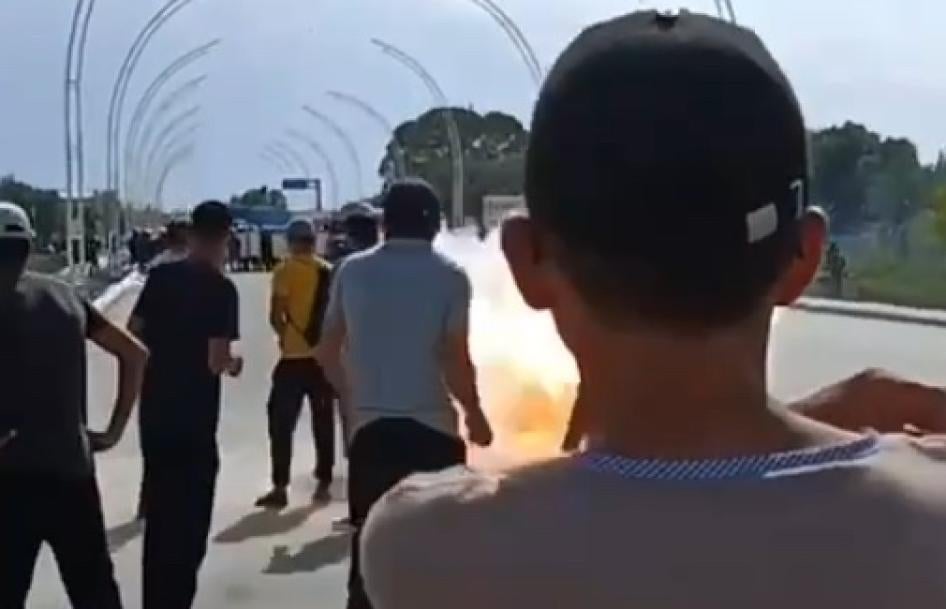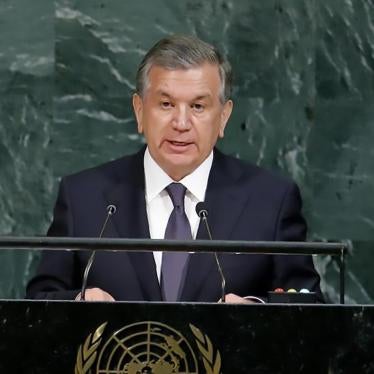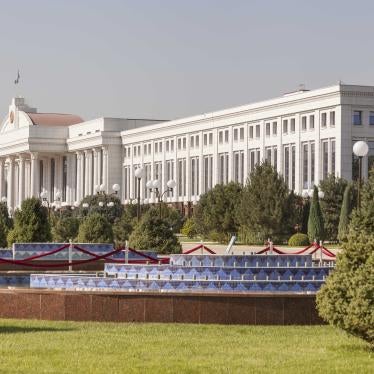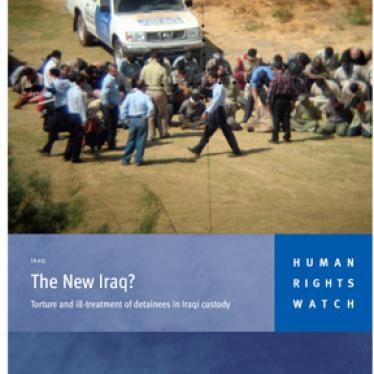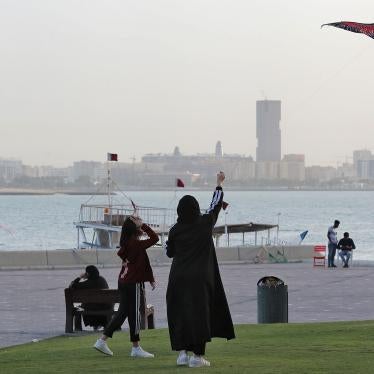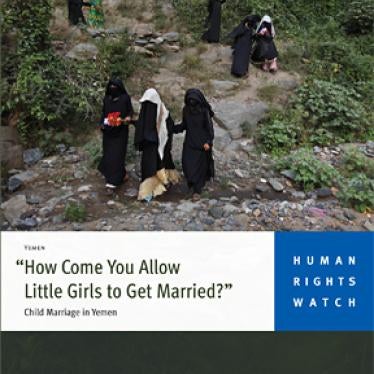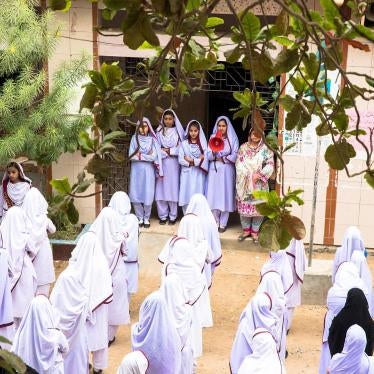(Berlin) – Uzbek security forces unjustifiably used lethal force and other excessive responses to disperse mainly peaceful demonstrators on July 1 and 2, 2022 in Karakalpakstan, Uzbekistan’s autonomous region, Human Rights Watch said today.
Security forces’ responses included the inappropriate use of small arms and various types of grenades, weapons that can cause severe injuries and death when used recklessly. At least 21 people died, including 4 law enforcement officers, and over 270 were injured. Uzbekistan should set an independent investigation into these events, including into the conduct of the security forces. It should also urgently review the use of certain categories of grenades used by Uzbek law enforcement in crowd control settings.
“Many people were killed and hundreds were injured – some with the most horrific injuries – in Karakalpakstan in July,” said Hugh Williamson, Europe and Central Asia director at Human Rights Watch. “Uzbekistan owes it to the victims to properly investigate how this happened and to hold accountable those responsible for serious violations.”
On July 15, parliament created a commission to investigate the events in Karakalpakstan in July. The 14-member commission includes officials, senators, representatives of civil society and experts, and is headed by the Uzbek human rights ombudswoman, Feruza Eshmatova. But it has neither issued a final report nor indicated when it plans to.
Human Rights Watch verified 55 videos of the protests and analyzed an additional 31 videos and 30 photographs of dead and wounded protesters and of weapons used that were recorded by participants or witnesses to the events in Nukus, the regional capital, and surrounding areas and uploaded to social media platforms between July 1 and August 1.
Through an independent medical analysis of the visual evidence, Human Rights Watch identified seven cases in which people sustained, and probably died from, severe tissue damage that was highly consistent with trauma caused by explosives.
Human Rights Watch verified two videos shot near the Tashkent Hotel in Nukus and uploaded to Twitter on August 1 that show protesters with severe injuries, such as skin lacerations and gaping flesh wounds, consistent with damage caused by explosives through the use of various types of grenades. These grenades, known variously as flash/bang, concussion, sound bombs, or stun grenades, are thrown by hand or projected by launchers. The grenades detonated in close proximity to crowds. In some cases, grenades also detonated when they hit protesters.
Human Rights Watch identified two other incidents, in Kanlykul, 65 kilometers northwest of Nukus, and near the monument to the Karakalpak Poet Berdakh in central Nukus, in which protesters experienced explosive trauma when security forces used projected flash/bangs and sound charges to disperse protesters.
Separately, Human Rights Watch identified two types of significantly heavier projected grenades, some of which are manufactured by Arsenal AD of Bulgaria, used during the protests that can cause significant injury or death. These grenades weigh 250-280 grams each, compared with 25-50 for standard grenades. The combination of velocity and mass means such grenades can deliver highly destructive and potentially fatal blows if they directly hit protesters at relatively short ranges. Human Rights Watch found evidence that at least one protester may have been killed by one of these heavier grenades.
Human Rights Watch also analysed a video of an injured protester with a wound that appears highly consistent with a gunshot injury.
Uzbekistan has an obligation to respect the rights to peaceful expression and assembly, including by ensuring that its security forces are trained and equipped to police demonstrations in rights-respecting ways. The inappropriate use of small arms and grenades violates several of Uzbekistan’s international human rights obligations.
The United Nations Basic Principles on the Use of Force and Firearms by Law Enforcement Officials state that security forces should “apply non-violent means before resorting to the use of force and firearms,” and always use the minimum necessary force. Intentional, lethal use of firearms is only permitted when strictly unavoidable to protect life.
The Uzbekistan authorities should urgently review the way security forces use hand-thrown and projected grenades for civil unrest and crowd control with a view to minimize future loss of life. Uzbekistan should withdraw such grenades from the Uzbek police arsenal to avoid any such deaths and severe injuries happening at future protests.
The United Kingdom, the United States, and the European Union have called for an independent investigation into events in the region. On July 5, the then-UN High Commissioner for Human Rights Michelle Bachelet called “for a prompt, independent and transparent investigation.”
The commission established under the Office of the Ombudsman is an important step by the authorities, especially the involvement of civil society representatives. However, there is no evidence it is investigating the deaths and severe injuries that occurred or the actions taken by the security forces, including the weapons they used. These issues are central to an independent investigation focused on accountability for the human rights violations that occurred.
Uzbek authorities should also investigate any reports of torture and mistreatment of detainees following the protests and bring those responsible to justice.
Uzbekistan’s international partners should reinforce the call for an independent investigation into human rights violations committed in Karakalpakstan and press the government to review the use of grenades deployed in crowd control. Uzbekistan’s partners, especially the EU and US, should calibrate relations with Uzbekistan based on measurable progress on these issues.
“The government’s response to the July events is a test of whether Uzbekistan has turned a page and truly intends to respect human rights and rule of law,” Williamson said. “It should not shy away from bringing to account security force personnel responsible for the deaths and injuries of so many people.”
For detailed findings and accounts, please see below.
Methodology
Human Rights Watch analyzed videos and photos posted on social media platforms, such as Telegram, Instagram, and TikTok, as well as 11 videos and photographs sent directly to Human Rights Watch researchers, to corroborate the available information and identify how the deaths and injuries occurred. Human Rights Watch also reviewed media reports, information from local human rights defenders, and official government statements, and consulted an independent medical analyst.
Human Rights Watch also wrote to the Uzbek ombudswoman for human rights, the internal affairs minister, and the General Prosecutor’s Office requesting information. Also, Human Rights Watch wrote to the Bulgarian company Arsenal AD, asking them to comment on the presence of RLV-SMK-3 grenades in Karakalpakstan. None have responded.
Many of the videos and photos were only shared several weeks after the end of the protests due to internet shutdowns and possibly due to threats of retaliation against protesters sharing information online.
July 1 and 2 Protests and Government Response
Following the publication of draft constitutional amendments on June 25, activists and journalists in Karakalpakstan started to voice concerns about the proposal to remove the right of Karakalpaks to vote on independence in a referendum and the reference to the sovereign status of the Republic of Karakalpakstan from Uzbekistan’s Constitution.
The autonomous Republic of Karakalpakstan, with a population of almost two million, covers about one third of Uzbekistan’s territory and became part of independent Uzbekistan in 1993. Both Uzbek and Karakalpak are official languages.
The authorities appear to have disrupted internet access in the region starting on June 27, with a complete shutdown from July 1. Internet Outage Detection and Analysis, an organization that identifies internet outages globally, reported that internet traffic in Karakalpakstan was intermittently cut between July 1 and 3.
Under international law, governments have an obligation to ensure that any restrictions to internet connectivity and information online are provided by law, are a necessary and proportionate response to a specific threat, and are in the public interest. Officials should never use broad, indiscriminate shutdowns to stop the flow of information or to harm people’s ability to express political views, including through peaceful assemblies.
Due to the internet shutdown and witnesses’ fear of retaliation for speaking out about the events, it is difficult to establish an exact timeline of events.
According to multiple media and Telegram accounts, the detention on July 1 of a prominent lawyer and journalist, Daulet Tazhimuratov, who had called for a peaceful rally in Nukus on July 5, served as the catalyst for people to take to the streets, calling for his release. Although Tazhimuratov was released later the same day, he was detained again on July 2. Police and law enforcement moved in to forcibly disperse protesters late in the evening of July 1.
Human Rights Watch is aware of incidents in which protesters threw stones and other objects at security officers and buildings, attacked an armored personnel carrier, and surrounded security force officers who had been stripped of their armor. However, Human Rights Watch research indicates that most protesters remained peaceful. In none of the scenes identified by Human Rights Watch where grenades or small arms ammunition were used did it appear that the lives of security force personnel or of others were under threat.
According to official figures, 21 people died during the events in Karakalpakstan, among them 4 security officers. The General Prosecutor’s Office said medical assistance was provided to 274 people. An assessment by Vitalii Ponomarev, a leading Central Asia expert, indicated that 34 people died during the events in Karakalpakstan, including a detainee apparently from ill-treatment in detention.
The General Prosecutor’s Office said 141 officers with the security forces and 16 citizens who suffered damage to their health and property were recognized as victims of “mass riots.” The government estimated that the protests caused approximately 3.147 billion soums (US$282,878) in property damage.
On July 2, President Mirziyoyev traveled to Nukus, where he announced that the proposed amendments referring to Karakalpakstan would be withdrawn.
The next day, Uzbek authorities imposed a state of emergency and a curfew in Karakalpakstan. These measures were lifted on July 21.
As of July 4, during and after the demonstrations, security forces had detained 516 people, according to the Prosecutor General’s Office. There is no updated official information regarding the total number of people still in detention.
President Shavkat Mirziyoyev blamed “foreign forces” for the events. Media reported that some detainees had alleged ill-treatment, including torture, and interference with their access to lawyers and family members. On July 8, the Prosecutor General’s Office announced that it had initiated a criminal case under article 159 of the Criminal Code of Uzbekistan in connection with alleged mass riots in Karakalpakstan. As part of the criminal investigation, security forces detained 14 people, including Tazhimuratov and Lоlagul Kallyhanova, a journalist, whom the authorities suspected of committing the crime “encroaching public safety.”
On July 21, Hook.report, an independent online media agency, reported that police were going door to door checking people’s digital devices for videos from the protests, and that if videos were found, police detained the phones’ owners for interrogation.
Since July 8, the Prosecutor General’s Office has not provided the public any updated information on the status of its investigations, including how many people are under arrest facing criminal charges. Human Rights Watch has not found any evidence that the authorities have opened criminal investigations into the civilian deaths and injuries apparently resulting from the use of lethal and other forms of excessive force by security officers, nor into allegations of ill-treatment and torture of detainees.
Human Rights Watch is aware of four activists from the Karakalpak diaspora who were detained in Kazakhstan in September and early October at Uzbekistan’s request and are currently under threat of extradition in connection with anti-state criminal charges.
Parliamentary Inquiry Commission
On July 15, Uzbekistan’s parliament established a commission tasked with investigating the events and human rights violations that took place in Karakalpakstan. According to the commission’s social media channels, it has met with lawyers, hospitalized protesters, security force officers, protest participants, civil society representatives, and Karakalpakstan residents to study the reasons for the protests, and to establish whether detainees have access to lawyers and are subjected to torture and other ill-treatment while in detention.
The commission is largely composed of either government officials or politicians or others who are close to the government. On this basis it is unrealistic to expect the commission to present genuinely independent findings, especially with respect to the actions of police and security forces. There has been limited transparency about the scope of the commission’s work and its mandate, and the intended outcome of the investigation.
The Global Alliance of National Human Rights Institutions, which accredits human rights bodies, rates Uzbek Ombudswoman’s Office as level B, meaning it only partially follows principles of independence. The Global Alliance report notes that the Ombudswoman's Office has not independently investigated some human rights violations, such as torture, sexual violence, and poor prison conditions, and that the office holder is not appointed in an independent manner.
Following appeals by the commission, 107 people who were detained during the protests have been released pending trial.
Explosive Trauma and Grenades
Human Rights Watch collected and analyzed 31 videos and 16 photos that in all showed 38 protesters who had been killed, wounded, or beaten during the July protests. Fourteen of them apparently suffered injuries highly consistent with explosive trauma, including penetrating lacerations and losing large portions of flesh. One video and four photos of these injuries also show black staining on the skin that surrounds the wound, suggesting the skin was burned or charred by an explosive item.
On July 7, 2022, Uzbekistan’s Internal Affairs Ministry posted a video to YouTube showing a tool kit containing equipment they said Uzbek security forces uses to disperse public disturbances. The contents all appear to come from the same Israeli company, ISPRA LTD. Some of the items match current products, including a G705-CS aluminium body teargas grenade, a G303-WS rubber body white smoke grenade, and a 303 STRB rubber body stun/rubber ball grenade. The other items appear to be earlier versions of the same products. Human Rights Watch verified a video posted to Telegram on July 20 and recorded northwest of Karakalpakstan’s Department of Development and Coordination of Vocational Education that shows a protester holding up to the camera an ISPRA LTD G303-ST stun grenade.
The person narrating the Internal Affairs Ministry video of the riot control tool kit states the grenades shown are “standardized grenades” that “don’t cause death,” although he admits that the 717 STRB, a stun and rubber ball grenade, “can cause injuries ... if fired from nearby, left in the hand or hit any part of the body.”
The Organization for Security and Co-operation in Europe’s Guidelines on Freedom of Peaceful Assembly state that “disorientation devices (flashbang or stun grenades) may fragment when exploding and carry risks of blast injuries” and that “the use of such [crowd control] weapons is insufficiently regulated or known, which leads to widespread use or misuse of such weapons, resulting in injury, disability or death of participants in assemblies.”
Human Rights Watch verified two videos that indicate wounds from the protests highly consistent with damage by explosives, or explosive trauma resulting from projected flash/bang, concussion, sound bombs, or stun grenades that directly hit protesters as they functioned.
One video, recorded to the west of the Tashkent Hotel in Nukus and shared on Twitter on August 1, shows a group of protesters gathered to the south of a line of security forces. A visible flash accompanied by an audible burst from the security forces’ location occurs 11 seconds into the video. One second later, an item detonated directly in front of a protester in a grey-blue shirt and dark shorts.
A second video shared the same day and recorded 50 meters southeast of the previous video shows a man in the same clothes limping away with the help of other protesters. The front of the man’s shorts has been torn open, exposing a large wound on his upper right thigh resembling other wounds from the protests that are highly consistent with explosive trauma.
Human Rights Watch identified two other cases in which protesters experienced explosive trauma in locations where Uzbek security forces used projected grenades to disperse protesters.
A video captured in Kanlykul, 65 kilometers northwest of Nukus, and posted to Telegram on July 23, shows security forces firing projected flash/bang grenades at a group of protesters about 100 meters northeast of them. The first grenade detonates near a protester and forces him to the ground. The nature of the protester’s injury is unclear, but someone can be heard saying, in Karakalpak language, “that man’s butt has been torn up” while other protesters surround and try to move the victim away from the security forces. Fourteen seconds later, another grenade detonates next to the person recording the video, forcing the protesters to run from the officers.
Another video shared on Telegram on July 2 and captured from approximately the same location across from security forces in the same formation as the video described above, shows several people around a man with a severe lower body wound wearing a light seafoam green shirt and white undershirt. The tissue around and below the man’s right hip has been visibly torn open. The man’s femur appears to be jutting out from the wound. The extent of this wound is much clearer in an additional video posted on Telegram on July 3, which shows a man in a hospital wearing the same clothing receiving surgery on a severe wound to his right rear.
“There is a bone out, a huge cavity, bleeding, spinal cord damage, and that is just on the face of it” said Dr. Rohini Haar, an emergency physician, whom Human Rights Watch consulted to analyze images and videos of casualties from the protests. “He is alive in the video and the doctor is trying to find all the bleeding vessels and clamp them off. But I can see he is bleeding out; it is not clear if he will survive this. If he does, he will not walk again.” Human Rights Watch cannot confirm this was the same man injured in the first video from Kanlykul.
A video shared on Telegram at 12:23 a.m. on July 3 and verified by Human Rights Watch shows a man with a traumatic open stomach wound lying in the street west of the Monument to Karakalpak Poet Berdakh in central Nukus. As another protester takes the victim’s pulse, security forces in the distance launch sound charge grenades toward them, forcing the protester to retreat. In the video three explosions are heard and seen in quick succession.
Human Rights Watch used photogrammetry analysis to confirm that security forces were between 90 and 110 meters from the protester lying on the ground. Someone can be overheard in the video saying in Karakalpak “a man is dying here, don’t shoot.” Another video posted on Telegram on July 2 shows the man lying motionless on the ground while someone says in Karakalpak “this guy’s intestines came out as a result of an explosion.” The man died from his wounds according to a video shared on Telegram on July 23.
A journalist with the Eurasianet media outlet, Joanna Lillis, visited Nukus within days of the protests and visited the Nukus city morgue where, she wrote, forensic pathologists had preliminarily determined that 18 of the fatalities were caused by what they termed “thermal” or “mechanical” injuries or a combination of the two.
Asel Kalymova, a senior examiner at the Nukus forensic testing center, said that “in layman’s terms, that means burns in the former case and being struck by a hard blunt object in the latter … Anything from a piece of metal to a car can cause mechanical injuries, while smoke grenades can cause thermal injuries.”
On July 3, a reporter from Gazeta.uz visited a hospital in Nukus and spoke to a man who said his son was injured by a flash/bang grenade while walking by the Muhammad Imam Aishan Mishti mosque. “He was walking to the mosque ... He sees people running toward him. If he had been running, the noise grenade would have hit him in the calves, from behind, but it hit him in front, in the bone. The grenade exploded in his leg;he removed it and his leg was left dangling.” The article includes a blurred photo of a person laying on a table bleeding through a bandage on their right shin. Human Rights Watch cannot confirm that this photo is of the person the man cited.
Human Rights Watch verified a video posted to Telegram on July 23 of security officers firing a smoke grenade toward protesters 360 meters west of the Muhammad Imam Aishan Mishti mosque. Another video, posted to Telegram on July 2 and filmed 650 meters northeast of the mosque’s grounds, shows protesters fleeing from a line of security officers who are deploying concussion grenades in their direction.
Forty-three seconds into the video an officer throws a concussion grenade toward a group of protesters who are carrying a man who appears to have a severely damaged right foot. The grenade detonates next to the protesters, forcing them to drop the wounded man and flee.
Heavy Projected Grenades
Human Rights Watch identified two types of heavy projected grenades used during the protests: Russian-made SV-1352/1 40mm “caseless” flash/bang grenades and 40mm RLV-SMK-3 smoke grenades manufactured by Arsenal AD of Bulgaria. They are substantially heavier than typical 37mm so-called less-than-lethal teargas grenades, weighing 250 and 280 grams respectively compared to the standard 25 to 50 grams.
A 2019 investigation by Amnesty International demonstrated that projected teargas and smoke grenades weighing 220 to 250 grams can cause severe wounds and death when fired directly at protesters. The combination of velocity and mass means grenades like the SV-1352/1 and RLV-SMK-3 can deliver highly destructive and potentially fatal blows if they directly hit protesters at relatively short ranges.
One man killed during the Karakalpakstan protests appears to have been hit in the chest by an SV-1352/1 grenade. A photo first posted on Telegram the morning of July 6, three days after the protests ended, shows an expended SV-1352/1 cartridge covered in blood and recently removed from a gaping wound. A video posted on Telegram 15 days later shows what appears to be the body of the same man, on a stretcher next to a cleaned SV-1352/1 grenade. The man’s chest cavity is open, and the person filming claims in Karakalpak that the SV-1352/1 is what struck and killed him. Human Rights Watch cannot confirm if the videos show the same grenade.
Use of ‘Live’ Ammunition
Human Rights Watch found evidence that Uzbek security forces were equipped with Kalashnikov-pattern rifles during the protests, as well as evidence of expended rifle cartridges.
Human Rights Watch analyzed a video of an injured protester with a wound that appears highly consistent with gunshot injury. The video was posted on July 3 to Yaplakal.com, an “entertainment community and news social network” based in Russia, and shows a man sitting on the ground bleeding profusely from a wound to his right shin.
“While the image is not well-defined, the injury appears to be consistent with a gunshot exit wound,” said Dr. Haar. “The injury is large and irregular and has outward bevelling of the skin and soft tissue, with some extruding tissue and no obvious burn or abrasion ring. The man appears to be in severe pain but stable, consistent with a single gunshot wound to the leg as well.” Protesters around the victim prepare rags to clean off the blood and can be heard discussing in Karakalpak if they should call an ambulance.
One video, captured north of the Nukus Sports Complex and posted to Telegram on July 2, shows an officer directing a vehicle with a water cannon while carrying a Kalashnikov pattern rifle. Human Rights Watch also identified two photos of a protester holding fired 5.45x39mm rifle cartridge, which is used by AK-74 variant Kalashnikov rifles.
Another video shared on Telegram on July 9 and recorded east of the Karakalpakstan Department of Development and Coordination of Vocational Education shows a protester holding two expended brass cartridges with bottle-neck designs, common characteristics of pistol ammunition.
The same Gazeta.uz reporter who went to a hospital in Nukus on July 3 and interviewed a man whose son was injured by a grenade wrote that nine people in the hospital reported being wounded by gunfire. The article includes an image that appears to show a bandaged gunshot wound to a person’s left leg. Human Rights Watch was unable to confirm the cause of this wound.
International Standards on Freedom of Assembly and the Use of Force
Governments are obliged, under international law, to protect the right to freedom of peaceful assembly, both by adopting measures to enable peaceful assemblies and by protecting demonstrators from violence directed at them by counterprotests or individuals. Restrictions on such assemblies should be permitted only to achieve a legitimate goal, such as protecting the rights of others, and then use the least intrusive measures that are necessary and proportionate to achieve that goal.
They should presume that all assemblies will be nonviolent, even in cases in which there may be isolated incidents of violence, or where small groups of external actors – such as counterprotesters or rioters – may engage in violence. Assemblies are often diverse gatherings, and participants do not lose their individual rights solely because a small number of people are behaving violently.
Assemblies may only be dispersed in “exceptional cases” such as when “the assembly as such is no longer peaceful, or if there is clear evidence of an imminent threat of serious violence that cannot be reasonably addressed by more proportionate measures.” In that event, law enforcement authorities should first give protesters ample opportunity to disperse, with clear instructions and open pathways.
Law enforcement officials, in general, should avoid the use of force to disperse peaceful protests, regardless of whether they deem the protests unlawful. Even in the event of violence, force should be used only if necessary and proportionate to address a genuine threat, and only as a last resort.
Lethal force should never be indiscriminately directed at crowds and should only be used in case of imminent threat to life.
